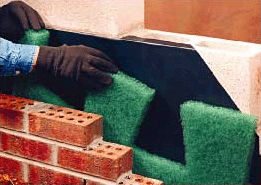The Advantages of Fluid-applied Air and Moisture Barriers
By Masonry
 Fluid-applied air and moisture barriers are an effective and economical means of controlling moisture in all types of wall assemblies, including concrete masonry units. Managing moisture helps to reduce potential mold growth in wall assemblies.
Fluid-applied air and moisture barriers are an effective and economical means of controlling moisture in all types of wall assemblies, including concrete masonry units. Managing moisture helps to reduce potential mold growth in wall assemblies.
A fluid-applied air and moisture barrier offers performance advantages over building wraps and traditional asphalt impregnated felt or paper moisture barriers. One advantage is that fluid-applied membranes are continuous, seamless and structural when applied to the sheathing. Building wraps, which are attached to the sheathing with penetrating fasteners, may create gaps that allow air infiltration.
The following are benefits of a fluid-applied air and moisture barrier:
- Creates a seamless moisture barrier with no tears, holes or "mis-lapped" joints, effectively blocking air leakage, and reducing energy costs and the risk of condensation in the wall.
- Protects sheathing and rough openings from weather damage during and after construction, minimizing associated repair or replacement costs.
- Simple installation procedures, needing no special tools or skills, reducing labor costs.
- Structural/full adherence creates rigidity and stability under air pressure loads, including wind.
- Provides the opportunity for pressure-equalized or pressure-moderated wall design, which minimizes risk of rainwater penetration through the wall assembly.
- Can be "value engineered" into bids and is easy to estimate.
When incorporating fluid-applied air and moisture barrier materials in wall assemblies, the following considerations are important to effectively control condensation and prevent moisture penetration:
- air permeability,
- air barrier continuity,
- air barrier structural integrity,
- air barrier durability,
- water penetration resistance,
- water vapor permeability,
- mechanical ventilation,
- construction details and sequencing,
- code compliance, and
- climate.
Sto Guard? is one choice in fluid-applied air and moisture barriers. The Sto Guard assembly consists of three products: Sto Gold Fill?, a spray- or trowel-applied joint treatment; Sto Guard? Mesh, a 9.5- or 4.25-inch wide adhesive reinforcing mesh used in conjunction with Sto Gold Fill; and Sto Gold Coat?, a waterproof coating applied by spray, roller or brush to wall sheathing to a prepared concrete masonry wall construction. Sto Guard provides superior protection against air and moisture intrusion in a variety of applications. Together these three components create a seamless, structural air barrier and moisture barrier that greatly improves resistance to air leakage and water infiltration resistance in comparison to sheet goods in wall assemblies.
For more information on fluid-applied air and moisture barriers, visit www.airbarrier.org or www.buildingscience.com.
About the Author
Masonry, the official publication of the Mason Contractors Association of America, covers every aspect of the mason contractor profession - equipment and techniques, building codes and standards, business planning, promoting your business, legal issues and more. Read or subscribe to Masonry magazine at www.masonrymagazine.com.


















